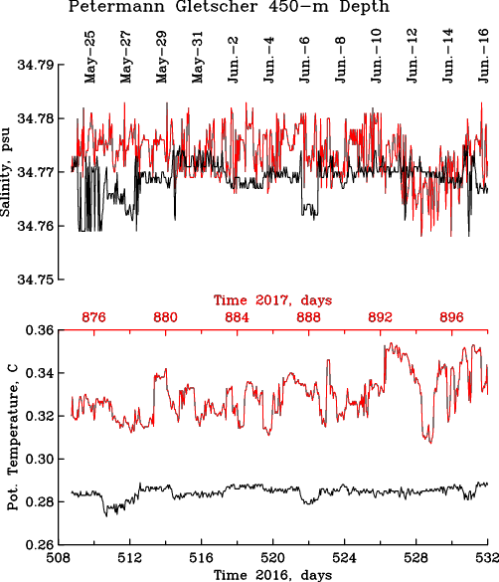Is Petermann Gletscher Breaking Apart this Summer?
16
June, 2017
I
am disturbed by new ocean data from Greenland every morning before
breakfast these days. In 2015 we built a station that probes the
ocean below Petermann Gletscher every hour. Data travels from the
deep ocean via copper cables to the glacier surface, passes through a
weather station, jumps the first satellite overhead, hops from
satellite to satellite, falls back to earth hitting an antenna in my
garden, and fills an old computer.
A
7-minute Washington Post video describes a helicopter repair
mission of the Petermann data machine. The Post also reported first
result that deep ocean waters under the glacier are heating up.

Sketch
of Petermann Gletscher’s ice shelf with ocean sensor stations. The
central station supports five cabled sensors that are reporting
hourly ocean temperatures once every day. Graphics made by Dani
Johnson and Laris Karklis for the Washington Post.
After
two years I am stunned that the fancy technology still works, but the
new data I received the last 3 weeks does worry me. The graph below
compares ocean temperatures from May-24 through June-16 in 2017 (red)
and 2016 (black). Ignore the salinity measurements in the top panel,
they just tell me that the sensors are working extremely well:

Ocean
temperature (bottom) and salinity (top) at 450-m depth below
Petermann Gletscher from May-25 through June-16 2017 (red) and 2016
(black). Notice the much larger day-to-day temperature ups and downs
in 2017 as compared to 2016. This “change of character” worries
me more than anything else at Petermann right now.
The
red temperature line in the bottom panel is always above the black
line. The 2017 temperatures indicate waters that are warmer in 2017
than in 2016. We observed such warming for the last 15 years, but the
year to year warming now exceeds the year to year warming that we
observed 10 years ago. This worries me, but three features suggest a
new ice island to form soon:
First,
a new crack in the ice shelf developed near the center of the glacier
the last 12 months. Dr.
Stef Lhermitte of Delft University of Technology in the
Netherlands discovered the new crack two months ago. The new rupture
is small, but unusual for its location. Again, the Washington
Post reported the new discovery:

New
2016/17 crack near the center of Petermann Gletscher’s ice shelf
as reported by Washington Post on Apr.-14, 2017.
Second,
most Petermann cracks develop from the sides at regular spaced
intervals and emanate from a shear zone at the edge. Some cracks grow
towards the center, but most do not. In both 2010 and 2012
Manhattan-sized ice islands formed when a lateral crack grew and
reached the central channel. The LandSat image shows such a crack
that keeps growing towards the center.

Segment
of Petermann Gletscher from 31 May 2017 LandSat image. Terminus of
glacier and sea ice are at top left.
And
finally, let’s go back to the ocean temperature record that I show
above.
Notice the up and down of temperature that in 2017 exceeds the
2016 up and down range. Scientists call this property “variance”
which measures how much temperature varies from day-to-day and from
hour-to-hour. The average temperature may change in an “orderly”
or “stable” or “predictable” ocean along a trend, but the
variance stays the same. What I see in 2017 temperatures before
breakfast each morning is different. The new state appears more
“chaotic” and “unstable.” I do not know what will come next,
but such disorderly behavior often happens, when something breaks.
I
fear that Petermann is about to break apart … again.




No comments:
Post a Comment
Note: only a member of this blog may post a comment.